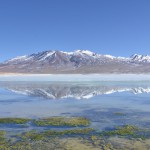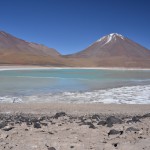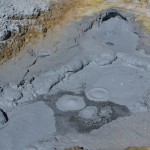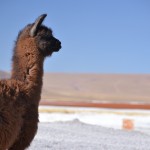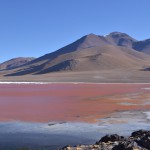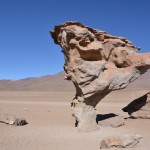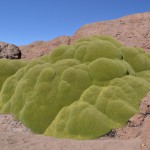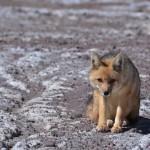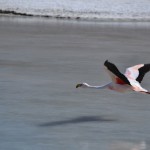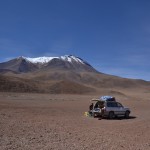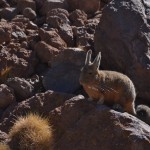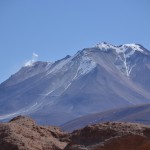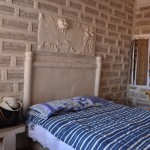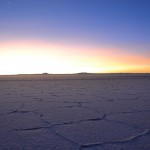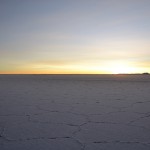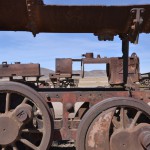One of the bigger and more adventurous plans on our honeymoon was the tour from San Pedro in Chile to Uyuni in Bolivia, through the Salar de Uyuni, the biggest salt desert in the world. There are many tour operators who offer this three-day tour, with nearly identical itineraries, but none of the operators has a perfect safety record unfortunately. There have been quite a few incidents with drunk drivers and accidents, so we did a lot of research to find the one that seemed safest. We settled for the company Estrella del Sur, for a variety of reasons: they have very few bad reviews, they have seat belts in all seats of the car (Bolivian law requires them only in the front seats), and they were willing to give us a guarantee – we paid only half in San Pedro and the other half at the end of the trip if we were happy with everything. They also let us review the customer feedback for our driver, Valerio, before we left, which gave us additional confidence.
The choice turned out to be great – Valerio was a great and safe driver, and a great guide providing a lot of explanations as well (in Spanish only, but we were able to understand most things, and were we didn’t, we could ask one of our fellow travelers who were native Spanish speakers).
The tour was organized as follows: after being picked up at the hostel in the morning, a mini bus took our small tour group of six people (a older Chilean guy, a Spaniard of roughly our age who had been working in Santiago for a couple of years, and two French girls on exchange year for their studies in Chile, and the two of us) to the Bolivian border. The Chilean border post is actually in the town of San Pedro, 45 minutes drive from the border, and at the border itself there is only a small shack for the Bolivian immigration officers. At the border, we met our Bolivian driver Valerio and changed cars into the Toyota Landcruiser that would be our vehicle for the next two and a half days. With driver and six people in the car, there was little space for luggage, so that went on the roof.
On the first day, we drove through the Avaroa national park. Like on the Chilean side, the landscape here is extremely dry, and even higher – some of the stops on the first day were up to 4900m high. At least, in contrast to our hike up Kilimanjaro a year and a half ago, this time we didn’t get altitude sickness (in contrast to some of our fellow travelers) – we were taking Acetazolamide (Diamox) for prevention and drank a lot of water (3-4 liters per person each day) which helped. In the national park, we visited various lagoons, including the crimson red Laguna Colorada, a geyser (not spraying as high as the one in Iceland, but constantly blowing steam and bubbling up mud) and also some thermal springs – in the cold desert it was really nice to sit in the 40 degree hot water!
The night we spent in a very basic hostel in the national park, with all six of us sleeping in one room. The night sky was again amazing so we took some more photos, even though it was freezing cold.
The next day, we left the park and went further north in the direction of the Salar. Along the way, we saw some interesting rock formations, including the “stone tree” (which isn’t a petrified tree, but just a rock with the shape of a tree) and some active volcanoes that we could see the smoke come out from (from a safe distance, of course). We also visited some more lagoons, including one with a lot of flamingoes. We also saw some more desert wildlife, including a desert fox, a viscacha (a rabbit-like animal with a long tail), some llamas and lots of vicuñas (look like llamas, but are always brown and have less fur).
This night, we spent in a nicer place in our own room: a salt hotel. Many houses around the Salar are built out of salt, with bricks basically cut out of the hard salt layers of the Salar, and a salt/water mixture used as mortar. This obviously makes a lot of sense here, since these resources are so readily available! The room was definitely much nicer than the dorm the night before, but still very cold during the night (even though we were now only at about 3600m elevation).
The next morning, we got up before sunrise, packed our things and drove out into the Salar. The Salar is really a surreal place. Completely flat, the ground hard as rock and white from the salt. It is extremely hard to judge distances or directions in this environment (which is why you can take funny perspective photos there, see below). We waited for the sun to rise (it was freezing, even though we were wearing all our layers), which was really extremely pretty, and then had breakfast in the middle of the Salar. Afterwards, we went to the cactus “island”. The island looks like an island in the middle of the salt, but there is no water to actually make it an island. It is covered in huge cacti, some of which are 5m or taller. We climbed up on top of the island’s central “hill”, and looking out over the Salar it really looked more like an ocean than the solid ground it is. After the island we drove some more though the Salar and took some pictures, and had lunch in a small village just outside of the Salar.
In the early afternoon, our tour ended in the town of Uyuni with a visit to the train cemetery, where Bolivia’s first steam engines were left to rust – a quite eerie sight. The town of Uyuni itself is much bigger than San Pedro, it has around 25000 inhabitants, but it’s definitely not a very nice town. The only thing we really enjoyed was the nice hotel we had booked, La Petite Porte, which had an actually working heating system (“guaranteed twenty degrees in the room”) and also was generally a very nice hotel.
From Uyuni, we continued on via La Paz to Lake Titicaca.
Some pictures follow.
- Laguna Blanca
- Laguna Verde
- Dalí desert
- Sol de Mañana geyser
- Sol de Mañana geyser
- Llamas
- Baby llama
- Laguna Colorada
- Árbol de Piedra
- Llareta plant
- Desert fox
- Flamingo
- Our car
- Vizcacha
- Active volcano
- Salt hotel
- Sunrise in the Salar de Uyuni
- Salar de Uyuni
- Isla Incahuasi
- Train cemetery
Tags: Bolivia, Honeymoon, Salar de Uyuni
